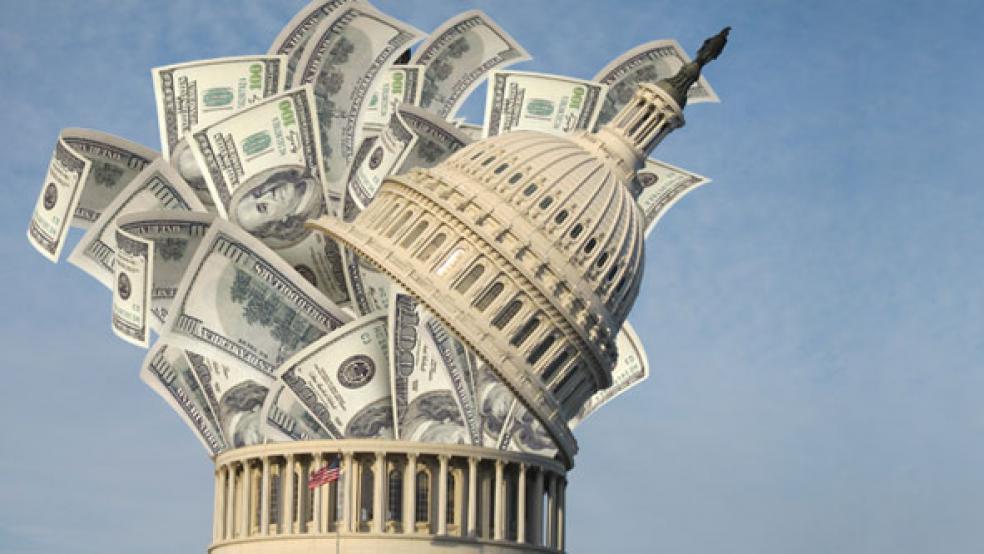One day this summer, the House of Representatives faced a decision. Should America cut off the money for Super Twiggy, the cartoon squirrel?
At that time, across-the-board budget cuts called sequestration were kicking children out of Head Start and leaving FBI agents without gas money. Congress was still supposed to be looking for smaller, smarter ways to trim the budget — so it could replace that big, dumb cut.
Related: NASA Makes Coburn's List for Wasteful Spending
So it came to Super Twiggy. The squirrel starred in Web videos in Spain, touting the health benefits of California-grown walnuts. U.S. taxpayers had paid more than $3 million for Spanish walnut promotions, as part of a $200 million-per-year Agriculture Department program that promotes U.S. farm goods overseas.
“The Republican majority was supposed to end this kind of nonsense, not perpetuate it,” said Rep. Tom McClintock (R-Calif.), trying to kill the broader program with an appeal to his party’s small-government soul. “It is a test of the determination and sincerity of the House majority.”
It didn’t work. After other members touted the program’s value to farmers, the cut was rejected, 322 to 98. There — in a vote and, in fact, in a nutshell — was the story of the American austerity wars in 2013.
Republicans in Congress had forced a historic shift: Washington, for the first time in years, was focused on cutting, not growing, the budget. But then, politicians in both parties choked on the decisions that came next: Where to cut. Who to hurt. What to kill.
Related: Government Blatantly Wastes $30 BIllion This Year
Instead, they allowed sequestration, a policy that — at least in theory — cut the good and the bad equally. That created odd contrasts: Meals on Wheels was cut, and Army units reduced training; Washington kept paying for dubious expenses such as a plane that didn’t fly, an airport with no passengers and farm subsidies in Manhattan. And a private industry’s “spokes-squirrel.”
This month, Congress canceled sequestration’s across-the-board cuts and gave itself another chance to demonstrate that legislators can make smarter, more judicious cuts. But so far, it has mainly demonstrated the power of old Washington habits, the political reflexes that make cutting government so hard.
“The only way Congress can make cuts is across the board, because they have trouble making decisions,” said Robert L. Bixby of theConcord Coalition, a group seeking to reduce the federal deficit. “If you’re trying to limit the scope of government, or the function, it doesn’t accomplish that goal at all. It just gives you less money to accomplish the same goals, which is why it doesn’t really work over the long term. [Either] the money grows back, or you provide a declining level of service.”
Three years after deficit-driven Republicans took the House, Washington’s experiment with budget-cutting has produced mixed results. Politicians have, indeed, had historic success cutting numbers — the abstract, friend-less figures at the bottom of the federal balance sheet.
In the next fiscal year, for instance, the government’s “discretionary” spending will be limited to $1.012 trillion. That figure was set by the budget deal agreed to last week. That’s down about 13 percent from 2010, adjusting for inflation. There has been very little change in “mandatory” spending programs, which account for the vast majority of federal spending.
But the budget deal signed in August 2011 was projected to save about $2.1 trillion by 2021, as compared with the levels of spending projected before. And to some conservatives, that’s victory enough. The big number went down.
“I’d much rather have [that] than to break my pick on some of this completely small-ball stuff,” said anti-tax advocate Grover G. Norquist. He said that it was unrealistic to expect Republicans to win many of those little battles, anyway: “You can’t line out anything. Because the Democrats run the Senate. The president has the veto.”
But to many other people — conservatives and liberals both — this is a dispiriting outcome. They expected more from austerity.
It was supposed to force Washington to face decisions about how the country really ought to spend its money. Finally, legislators would eliminate the duplicative, wasteful or profligate programs that they’d ignored in fatter times.
In 2011 and 2012, for instance, at least 84 federal programs were either eliminated or defunded by Congress. In large part, however, these were not major reforms. The programs cut were often small, redundant, outdated or all three. In 72 of those cases, the cuts had been suggested by the Obama administration.
The suggestions included a scholarship named in honor of Sen. Robert C. Byrd (D-W.Va.), another named for Byrd’s wife, as well as an anti-drug center championed by Rep. John P. Murtha (D-Pa.), and a scholarship named for the son of Rep. Bart Stupak (D-Mich.). At the time, Stupak had already retired. Byrd and Murtha were dead.
Related: Fed Agency Stuffs Special Interest Stockings with $50M
For many conservatives, that adds up to an unsatisfying result. They had wanted a government that was cheaper, smaller and smarter. Suddenly, they were being asked to settle for just cheaper.
“Have we eliminated anything? No. We haven’t,” said Rep. Mick Mulvaney (R-S.C.), a conservative in his second term. “I can’t think of a single major agency that we’ve gotten rid of. Or a role of government that we’ve gotten rid of.”
So how did Congress manage to cut the budget overall, while leaving so much of government’s parts intact?
One answer was an old Washington trick: budget gimmicks, which cut money on paper but made little difference in the real world.
In 2011, for instance, Congress and President Obama trumpeted a budget dealthat included $37.8 billion in budget cuts. But upon close inspection, many of those cuts were only-in-Washington illusions, paper money that was unlikely to ever be spent. The “cuts” in that case included $6 billion for a census that wasn’t necessary, $280 million for a tunnel that was already canceled and $375,000 for a road that didn’t exist (the money had been allotted to a fictional road because of a typo).
Another answer was distraction and theatrics in Congress — another bad habit, which left legislators little time to dig into the details of the budget and agree on what was too wasteful or extraneous to keep.
In early 2011, Democrats blocked many of the biggest cuts that Republicans had proposed, including defunding Planned Parenthood and NPR. After that, the two sides began a cycle of hair-pulling crises, each of which was resolved in a series of last-minute deals. Often, the outcome of the showdown was a “continuing resolution,” a stopgap measure that mainly continued funding levels at levels set previously.
And finally, even when legislators focused on a real-world cut, even small-government Republicans often found reasons to keep government doing the same things it did before.
So it was with Super Twiggy, one of several controversial giveaway programs that legislators couldn’t cut loose.
The program that funds Super Twiggy — the USDA’s Market Access Program — has been criticized for spending taxpayer money to advertise for private business interests. But it lives, partly because its benefits are spread among so many farmers in so many states.
Since 2008, the program has paid more than $3.1 million to help the California Walnut Commission advertise in Spain. First, the money paid for ads with a live squirrel, Twiggy, who snacked on walnuts and then water-skiied behind a miniature boat.
“Then, Twiggy retired. The real squirrel. So we reinvented, I guess, a digitized Twiggy,” said Dennis Balint, the walnut commission’s chief executive.
Now the commission produces Web videos where the new, digital squirrel has adventures inside the human body, hurling walnuts at villains who symbolize cholesterol. It is a bit of an odd metaphor — because having either a live squirrel or a walnut inside one’s blood vessels would probably be a more immediate concern than hardening of the arteries.
But the walnut commission thinks it’s a worthwhile use of their aid money. Their research shows that Spaniards, in particular, respond well to squirrels.
“Twiggy being inside the blood vessel is a way of demonstrating the fact that cholesterol — bad cholesterol — can be beaten with walnuts,” Balint said.
On the House floor this summer, proponents of the Market Access Program brushed aside the mention of Super Twiggy and argued that the program should stay because it helps farmers.
“Since the creation of this extremely successful agricultural export program, it has increased America’s export by over 500 percent. That is a success story by any measure,” said Rep. Jim Costa (D), who represents a heavily agricultural district in California. Two Republicans and another Democrat also spoke in opposition to the cut.
When the vote came, 142 Republicans and 180 Democrats voted to keep it.
This article originally appeared in The Washington Post.
Read more in The Washington Post:
Three Ominous Signs for Democrats
Police File on Newtown Yields Chilling Portrait
The 10 Worst Leadership Moments of 2013





